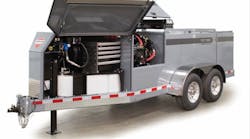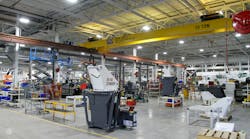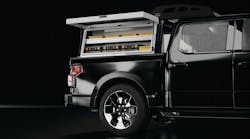THE aftermarket “sweet spot” isn't very sweet right now. In fact, it's more like a rice cake than a chocolate bar.
In “The Heavy Duty Aftermarket Outlook: Opportunities and Challenges,” Stu MacKay, president of MacKay and Company, said that the industry is technically out of the recovery phase after The Great Recession, but the expansion phase is going very slowly.
“I don't think there is any question that we are behind where we thought we'd be 40 months ago,” he said. “Looking at the historical track of GDP, we really are growing at a much slower rate. We just don't have the growth engine we had for a very long time — well into the 1980s or beyond. Employment has a long way to go. We have four million jobs we don't have now that we had before. The prognosis does not seem to indicate that's going to change much over next year or two.
“By and large, on average, seven or eight years after a new Class 8 truck comes out of the factory, that's about where the aftermarket business driven by that truck really becomes significant because we are into the overhauls for major components. If you look at the period from 2000-2006, we had a long sweet spot. We put a lot of trucks on the street from 2003 into 2007. One year, we had close to 300,000. What we're getting now is the benefit of that sweet spot from seven or eight years ago.
“If look at the track since 2009, it's a much lower track and much smaller sweet spot. If we take 2010-2012 and roll that out to 2015-2018, we are not going to have the same operating universe driving the aftermarket that we have today. And I think a lot of people are not happy with the aftermarket we have today. What was in place six or seven years ago drives the aftermarket today, and if we don't have the same kind of sweet-spot levels going forward, we're not going to have the same kinds of results.
“The structure of the truck business is changing. Medium-duty sales were close to 270,000 a year and are now down to around 170,000. There are a lot fewer medium-trucks being used in the distribution of products on the North American market today. Even if the economy started to heat up, most of the manufacturers would be cautious about ramping up. They've been burned before and are much more cautious.”
MacKay said US medium-duty sales as a percentage of Class 8 Sales have dropped from well over 200% to about 50%.
“The medium-duty market hasn't collapsed, but it certainly has cratered,” he said. “The productivity of trucks in service today is dramatically better than it was 10, 20, 30, 40 years ago. We've gone from requiring 65,000 medium-duty trucks for every $100 billion of Truckable Economic Activity to about 25,000. It's not as severe when you take a look at the Class 8 market, but that's gone from 42,000 to 27,000.
“We're building better products and they are being much more effectively used. Bob (Dieli, an earlier speaker) cited things like GPS and tracking and changes in suspension. Certainly we have more consolidation in industries that are shipping products and a much greater ability to more effectively manage it, and this is the result of it. We have been victims of our own success.”
He said the fleets' revenue miles are not cratering, but there isn't much strength there — and hasn't been for several months.
Even when that index was strong — in August 2011 — it was up only 4%. It fell to zero in December 2011, recovered briefly to 2% in March 2012, but dropped down below zero last November.
“There isn't strength at this point in time, based on the sample we're using, to indicate we have a lot of new activity that's going to move this market up in the near term,” he said.
Fuel sales plunge
The Truck Stop Index, which measures diesel fuel sales, peaked in June 2007 and is now only 67% of what it was then.
“Some of that may be shifting from owner-operators who would typically be fueling in truck stops to fleets who will pull that back in house and do internal fueling,” he said. “But I think it's more significant than that. That's a major drop-off, and it's a concern of ours. It's stable at the end, but there isn't any growth tail we can see at this time.”
Dealer parts sales also have plunged. The year-over-year change peaked at 20% in December 2010, declined steadily and plunged below zero for the first time last November.
“I would assume that part of that has to be due to financial uncertainty and political uncertainty,” he said. “What's happening in Washington? And how will that affect the tone of business? Dealers, at least the ones we have surveyed, have been pulling back.”
The same thing has been happening with dealer parts inventory, with a steady decline to -2.5% in November.
Independent distributors' parts sales have gone from barely positive in September (2.6%) to -2.8% in October and -3.3% in November.
“I'm not awfully bullish in the short term,” MacKay said. “It would be very helpful if we could clear up a whole bunch of issues that relate to Washington, and I don't think that's going to happen,” he said. “It's hard to see it's going to get any better.
“I think we have to live with what we've got. Our short-term outlook is not really any different from what we've seen over the last several years. Is it seriously negative? No. Seriously positive? No. Will it tail along like we've been seeing? I think that's the best expectation within the next 12, 15, maybe 18 months.”
In the long term, he said the issue of fleet consolidation will continue.
“We aren't done with the shakeout in the for-hire market and I think we'll see more consolidation in the private fleet market,” he said. “That will probably rescue the number of vehicles serving that segment of the market.
“From a personal perspective, I don't think there's any question about the further consolidation of the distribution system. Objectively, what we've seen so far works pretty well. When you look at the Rush organization, or FleetPride or TruckPro, they've been pretty successful. Maybe suppliers will be more difficult to deal with because you have much more leverage at that end of the scale. The automotive aftermarket is squeezing their primary suppliers and hopefully we won't get into that situation, but we should expect further consolidation.
“There will be an increased emphasis on remanufacturing and rebuild. Where it's appropriate — where you have a core-value product — the opportunities to save money by remanufacturing and rebuilding are significant. Schneider is a typical large buyer of new trucks, but is on a fairly long trade cycle. Over the last 12 to 18 months, they've had 650 tractors in their fleet pulled out and basically remanufactured from a slider-kit concept — 650 new trucks that didn't get built. They wound up with new power and electronics for 40% to 50% of the cost of putting a new truck on the road. If it works for Schneider — because they're some of the smart guys in this business — it should work for everybody else.
“Two other transportation industries have taken different approaches. In the railroad industry, it's not unusual for a line-haul locomotive to be 20 to 25 years old. It's been upgraded, probably been repowered, and may have new electronics and control systems, but the core is 20 to 25 years old.
“American Airlines has a lot of planes that are 20 or 25 years old. They overhaul them and maintain them. Yeah, a locomotive costs a half-million dollars or a million dollars, and a truck costs $100,000. Airplanes cost $5 or $10 or $20 million, but I think it's the same issue — making more effect utilization of a capital investment. I think that's good for the aftermarket. The guys down in Tennessee who are remanufacturing Schneider's trucks are doing very well. I don't know where all the parts or components are coming from, but a lot of product has flowed through that organization in the last 18 months.”
He said that although the truck universe growth will be slower and “being cautious in this point in time is being prudent,” there is some good news on the aftermarket front: it's a $22 billion opportunity; the market is cycle-resistant; the market will continue to grow; consolidation equals a stronger customer base and stronger distribution.
Answering key questions
Summarizing what was discussed earlier in the day, he answered five questions:
What did the fleets tell us?
- Availability. “From their perspective you're still #1. That's why they buy where they buy.”
- Brand value risks are being undercut by a variety of factors and brand value is something they put a lot of stock in.
- Training is critical but needs to be adapted to their availability of receiving and accepting training and integrating into their programs.
- Independent distributors tend to be more responsive than typically the OEM dealer.
- Fleets are willing to pay for quality that actually delivers. They're not willing to pay simply for a name or concept, but for a product that works out.
What did distribution tell us?
- Customer consolidation hurts.
- The value proposition from suppliers is not always consistent.
- Product complexity is increasing and the ability of recipients to absorb technology seems to be decreasing.
- Reconfiguring of inventory is less of an expense and more of an asset.
- Being a legitimate supplier is important not only to the customer but to the distribution business itself. The question is, are we headed toward something more akin to industrial distribution than what we have known traditionally as truck parts distribution?
What did the suppliers tell us?
- Product longevity is mandatory. It's not an option anymore.
- Product differentiation is the one true alternative to decommoditization.
- There is a necessity to structure the product, whether it's a vehicle or component for the first owner or second owner or third owner, because the product is going to live through many of those cycles and needs to be adapted to each of those subsequent uses.
- Remanufacturing where it's appropriate is the top priority.
- Feet on the street still sells products.
- Premium products can be marketed, and training is critical.
Pete Joy, vice president of sales and marketing for Phillips Industries, joined MacKay at the end of the session, and said that the aftermarket index — which represents the results of 17 suppliers — has experienced a dip since March 2012.
“What concerned me was the impact of another subject: private-brand programs and those will-fit products sold through distribution from dealers to end users, and their sales don't show up in the index,” he said. “Should we be looking at the index from a different perspective? It forecasts the health of the supplier community, but not so much the health of aftermarket, or the trend of the aftermarket.”
Addressing the numbers shown in graphics — 42% of final sales are coming from the dealer segment and 28% from the distributor segment — he asked Mackay if he saw any trends.
“There are certain things going on within the 42% and 28%, and as we look at consolidation within various channels,” MacKay said. “We start with all products we track, take a look at point of service and then consumption and aggregate all information and come up with those numbers. The structure inside those two major groups is changing with consolidation. With people being acquired and absorbed and expanding, I'm fairly comfortable with steady/stable next few years. We haven't seen anything significant that would move the needle very far at this time. As for parts flowing in from other sources, that could have some impact but in most cases those parts are displacing parts and components that would come down from traditional channels.
“A couple of points where we will see changes: Proprietary engines are basically taking the distributor if not completely out of equation, then significantly out. Cummins to its credit has developed a whole slew of business that doesn't rely on the truck industry anymore. Detroit Diesel has been rolled into Daimler. Paccar has the MX DEF engine coming in, which is going to push the parts business back to dealers more.”








